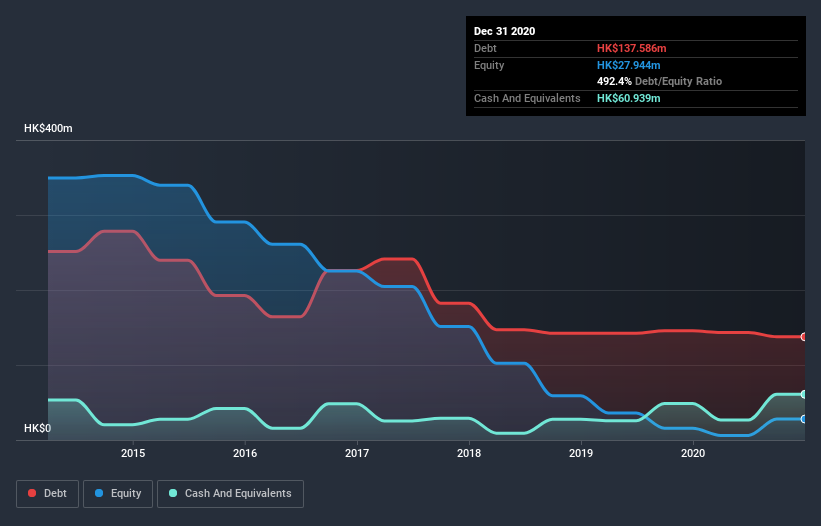
Legendary fund manager Li Lu (who Charlie Munger backed) once said, 'The biggest investment risk is not the volatility of prices, but whether you will suffer a permanent loss of capital.' It's only natural to consider a company's balance sheet when you examine how risky it is, since debt is often involved when a business collapses. Importantly, Guangdong Tannery Limited (HKG:1058) does carry debt. But the real question is whether this debt is making the company risky.
When Is Debt Dangerous?
Debt assists a business until the business has trouble paying it off, either with new capital or with free cash flow. In the worst case scenario, a company can go bankrupt if it cannot pay its creditors. However, a more common (but still painful) scenario is that it has to raise new equity capital at a low price, thus permanently diluting shareholders. Of course, plenty of companies use debt to fund growth, without any negative consequences. The first step when considering a company's debt levels is to consider its cash and debt together.
Check out our latest analysis for Guangdong Tannery
What Is Guangdong Tannery's Debt?
You can click the graphic below for the historical numbers, but it shows that Guangdong Tannery had HK$135.9m of debt in December 2020, down from HK$145.5m, one year before. However, it also had HK$60.9m in cash, and so its net debt is HK$74.9m.

How Strong Is Guangdong Tannery's Balance Sheet?
According to the last reported balance sheet, Guangdong Tannery had liabilities of HK$62.6m due within 12 months, and liabilities of HK$161.0m due beyond 12 months. Offsetting these obligations, it had cash of HK$60.9m as well as receivables valued at HK$72.3m due within 12 months. So its liabilities outweigh the sum of its cash and (near-term) receivables by HK$90.4m.
This is a mountain of leverage relative to its market capitalization of HK$139.9m. Should its lenders demand that it shore up the balance sheet, shareholders would likely face severe dilution. The balance sheet is clearly the area to focus on when you are analysing debt. But you can't view debt in total isolation; since Guangdong Tannery will need earnings to service that debt. So if you're keen to discover more about its earnings, it might be worth checking out this graph of its long term earnings trend.
In the last year Guangdong Tannery wasn't profitable at an EBIT level, but managed to grow its revenue by 7.7%, to HK$191m. That rate of growth is a bit slow for our taste, but it takes all types to make a world.
Caveat Emptor
Over the last twelve months Guangdong Tannery produced an earnings before interest and tax (EBIT) loss. Indeed, it lost HK$977k at the EBIT level. Considering that alongside the liabilities mentioned above does not give us much confidence that company should be using so much debt. So we think its balance sheet is a little strained, though not beyond repair. For example, we would not want to see a repeat of last year's loss of HK$2.8m. So we do think this stock is quite risky. When analysing debt levels, the balance sheet is the obvious place to start. However, not all investment risk resides within the balance sheet - far from it. For instance, we've identified 2 warning signs for Guangdong Tannery that you should be aware of.
If, after all that, you're more interested in a fast growing company with a rock-solid balance sheet, then check out our list of net cash growth stocks without delay.
If you’re looking to trade Guangdong Tannery, open an account with the lowest-cost* platform trusted by professionals, Interactive Brokers. Their clients from over 200 countries and territories trade stocks, options, futures, forex, bonds and funds worldwide from a single integrated account. Promoted
Valuation is complex, but we're here to simplify it.
Discover if Namyue Holdings might be undervalued or overvalued with our detailed analysis, featuring fair value estimates, potential risks, dividends, insider trades, and its financial condition.
Access Free AnalysisThis article by Simply Wall St is general in nature. It does not constitute a recommendation to buy or sell any stock, and does not take account of your objectives, or your financial situation. We aim to bring you long-term focused analysis driven by fundamental data. Note that our analysis may not factor in the latest price-sensitive company announcements or qualitative material. Simply Wall St has no position in any stocks mentioned.
*Interactive Brokers Rated Lowest Cost Broker by StockBrokers.com Annual Online Review 2020
Have feedback on this article? Concerned about the content? Get in touch with us directly. Alternatively, email editorial-team (at) simplywallst.com.
About SEHK:1058
Namyue Holdings
An investment holding company, engages in the processing and sale of semi-finished and finished leather in Mainland China.
Excellent balance sheet and slightly overvalued.
Market Insights
Community Narratives



